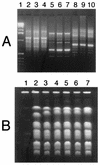Fluconazole resistance associated with drug efflux and increased transcription of a drug transporter gene, PDH1, in Candida glabrata
- PMID: 9661006
- PMCID: PMC105668
- DOI: 10.1128/AAC.42.7.1695
Fluconazole resistance associated with drug efflux and increased transcription of a drug transporter gene, PDH1, in Candida glabrata
Abstract
Sequential Candida glabrata isolates were obtained from the mouth of a patient infected with human immunodeficiency virus type 1 who was receiving high doses of fluconazole for oropharyngeal thrush. Fluconazole-susceptible colonies were replaced by resistant colonies that exhibited both increased fluconazole efflux and increased transcripts of a gene which codes for a protein with 72.5% identity to Pdr5p, an ABC multidrug transporter in Saccharomyces cerevisiae. The deduced protein had a molecular mass of 175 kDa and was composed of two homologous halves, each with six putative transmembrane domains and highly conserved sequences of ATP-binding domains. When the earliest and most azole-susceptible isolate of C. glabrata from this patient was exposed to fluconazole, increased transcripts of the PDR5 homolog appeared, linking azole exposure to regulation of this gene.
Figures






Similar articles
-
The ATP binding cassette transporter gene CgCDR1 from Candida glabrata is involved in the resistance of clinical isolates to azole antifungal agents.Antimicrob Agents Chemother. 1999 Nov;43(11):2753-65. doi: 10.1128/AAC.43.11.2753. Antimicrob Agents Chemother. 1999. PMID: 10543759 Free PMC article.
-
Identification and expression of multidrug transporters responsible for fluconazole resistance in Candida dubliniensis.Antimicrob Agents Chemother. 1998 Jul;42(7):1819-30. doi: 10.1128/AAC.42.7.1819. Antimicrob Agents Chemother. 1998. PMID: 9661028 Free PMC article.
-
Pdr1 regulates multidrug resistance in Candida glabrata: gene disruption and genome-wide expression studies.Mol Microbiol. 2006 Aug;61(3):704-22. doi: 10.1111/j.1365-2958.2006.05235.x. Epub 2006 Jun 27. Mol Microbiol. 2006. PMID: 16803598
-
Antifungal drug resistance in pathogenic fungi.Med Mycol. 1998;36 Suppl 1:119-28. Med Mycol. 1998. PMID: 9988500 Review.
-
Candida and candidaemia. Susceptibility and epidemiology.Dan Med J. 2013 Nov;60(11):B4698. Dan Med J. 2013. PMID: 24192246 Review.
Cited by
-
Fungal infections in animals: a patchwork of different situations.Med Mycol. 2018 Apr 1;56(suppl_1):165-187. doi: 10.1093/mmy/myx104. Med Mycol. 2018. PMID: 29538732 Free PMC article. Review.
-
Efflux in fungi: la pièce de résistance.PLoS Pathog. 2009 Jun;5(6):e1000486. doi: 10.1371/journal.ppat.1000486. Epub 2009 Jun 26. PLoS Pathog. 2009. PMID: 19557154 Free PMC article. Review.
-
An Overview on Conventional and Non-Conventional Therapeutic Approaches for the Treatment of Candidiasis and Underlying Resistance Mechanisms in Clinical Strains.J Fungi (Basel). 2020 Feb 10;6(1):23. doi: 10.3390/jof6010023. J Fungi (Basel). 2020. PMID: 32050673 Free PMC article. Review.
-
Fungal PDR transporters: Phylogeny, topology, motifs and function.Fungal Genet Biol. 2010 Feb;47(2):127-42. doi: 10.1016/j.fgb.2009.10.007. Epub 2009 Oct 24. Fungal Genet Biol. 2010. PMID: 19857594 Free PMC article. Review.
-
Biology of the pathogenic yeast Candida glabrata.Folia Microbiol (Praha). 2006;51(1):3-20. doi: 10.1007/BF02931443. Folia Microbiol (Praha). 2006. PMID: 16821705 Review.
References
-
- Balzi E, Wang M, Leterme S, Van Dyck L, Goffeau A. PDR5, a novel yeast multidrug resistance conferring transporter controlled by the transcription regulator PDR1. J Biol Chem. 1994;269:2206–2214. - PubMed
-
- Carvajal E, van den Hazel H B, Cybularz-Kolaczkowska A, Balzi E, Goffeau A. Molecular and phenotypic characterization of yeast PDR1 mutants that show hyperactive transcription of various ABC multidrug transporter genes. Mol Gen Genet. 1997;256:406–415. - PubMed
Publication types
MeSH terms
Substances
Associated data
- Actions
LinkOut - more resources
Full Text Sources
Other Literature Sources
Molecular Biology Databases

